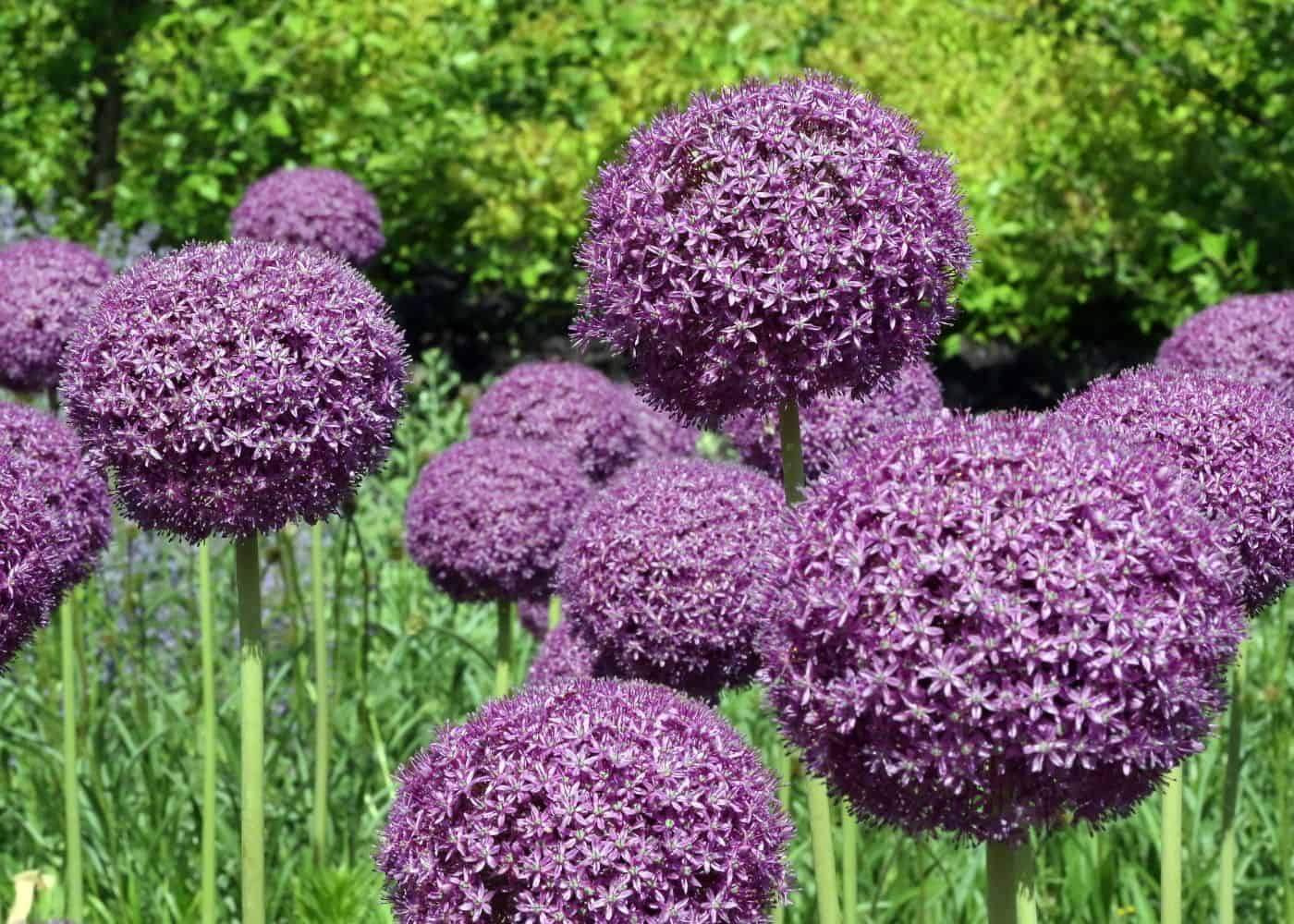This comprehensive guide on how to grow alliums will walk you through the captivating world of alliums, from selecting the perfect variety to planting, caring, and showcasing these exquisite plants in your garden.
How to grow alliums
Alliums are a captivating and versatile group of plants that can transform any garden into a stunning masterpiece. By choosing the right variety, providing proper planting conditions, and caring for your alliums, you can enjoy a beautiful and vibrant display of these unique plants year after year.
Start by choosing the right allium variety for your garden from a wide selection of large, small, and unique varieties. Before planting, create an ideal environment with full sun exposure, well-drained soil amended with organic matter like homemade compost.

For best results when learning how to grow alliums, plant them in full sun in a well-drained spot in your garden. Bury the bulbs 4-8” deep and 6-8” apart with their pointed ends facing up. Read the instructions for the specific variety you’ve purchased, as the planting depth varies by species. Plant them in the fall or early winter after the first frost but before the ground freezes, water once, and wait for spring blooms.
Alliums are perennials and return each year if planted in a suitable environment. Healthy allium bulbs will multiply over time, with offsets being pushed out of the soil and visible in late autumn or early spring. These can then be carefully lifted and replanted into the soil.

Choosing the right allium variety
With over 700 species in the genus Allium, there’s an allium variety to suit every garden design and preference. Maximizing the beauty and harmony of your garden hinges on finding the right allium.
This section delves into large, small, and unique allium varieties, aiding your selection of the perfect garden addition.
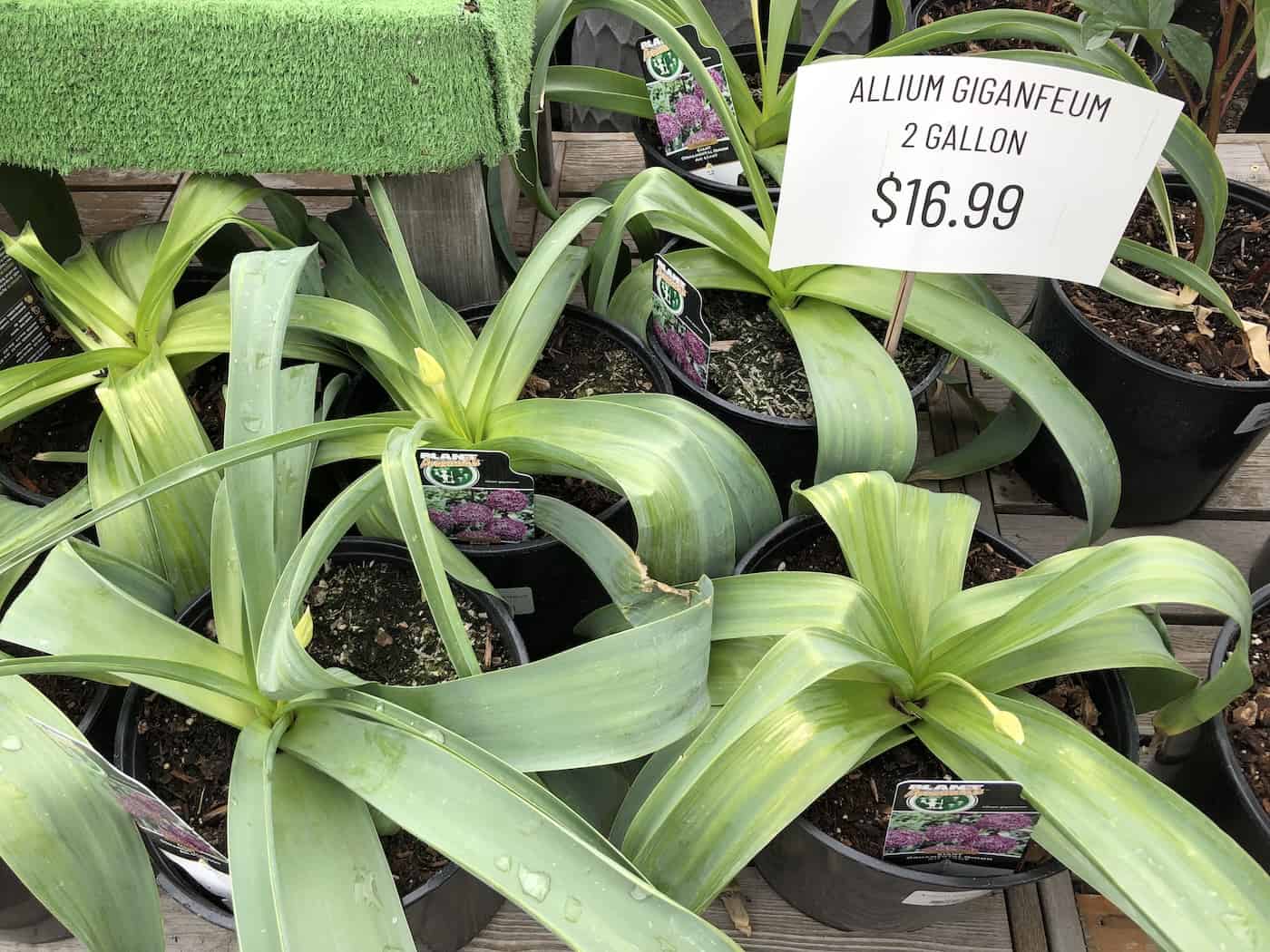
Large alliums
Large alliums, such as Allium giganteum and ‘Gladiator’, are known for their impressive size and dramatic presence in the garden. These captivating plants:
Produce large, spherical flower heads on tall, sturdy stems
Bloom in a range of deep purple hues in early summer
Make a bold statement in garden beds
Serve as stunning cut flowers for indoor arrangements
Some popular large allium varieties include ‘Purple Rain’, ‘Globemaster’, ‘Beau Regard’, and ‘Mont Blanc’. These plants are deer and rodent-resistant, and their tall stems provide an excellent contrast to the lower-growing plants in your garden. Plant the bulbs of these large alliums, which are among the most allium flowers, in well-draining soil with full sun exposure.
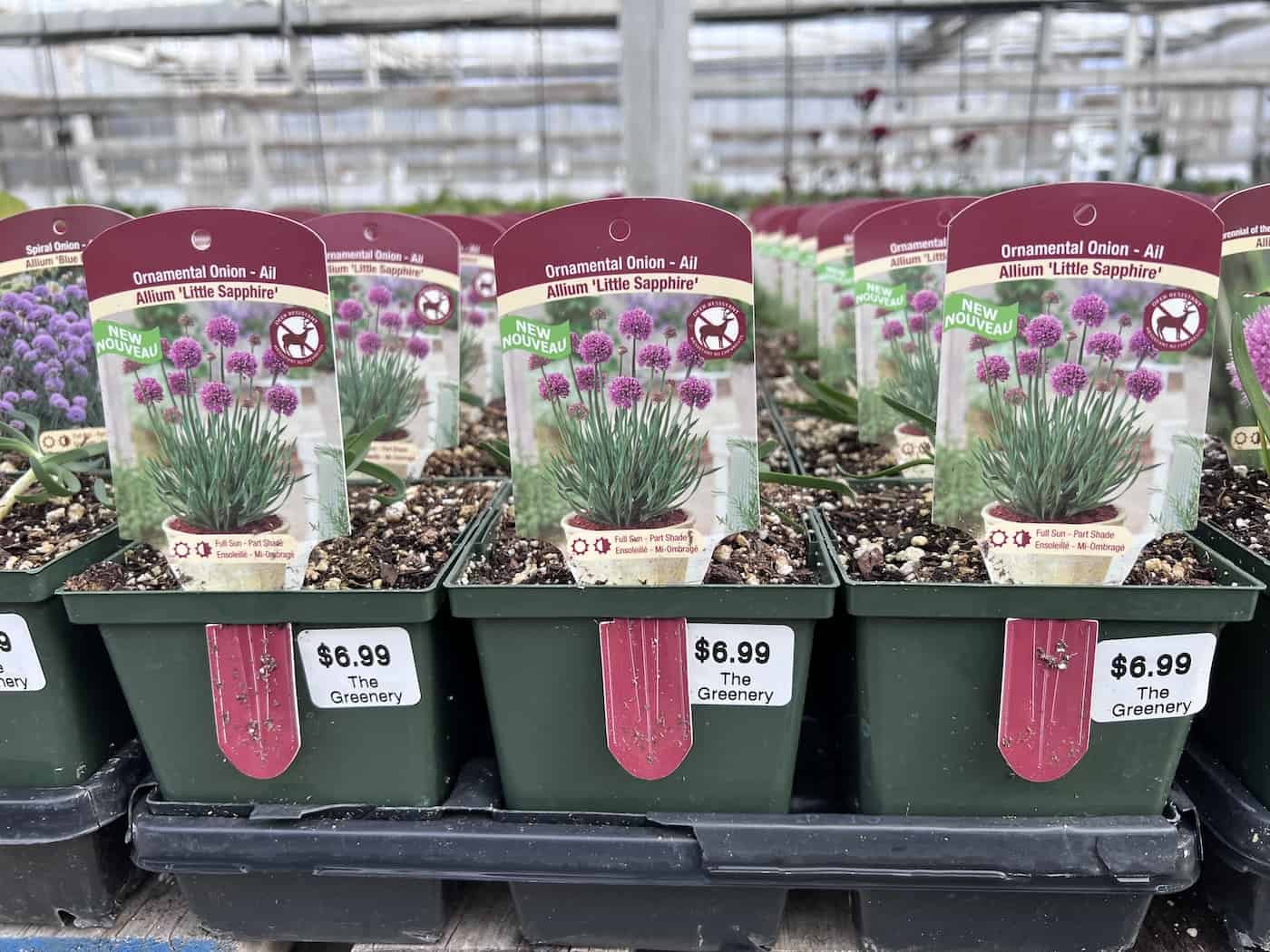
Small alliums
Small allium varieties, like Allium christophii and Allium cernuum, offer a more delicate touch to your garden design. These charming plants produce dainty flower heads in various colors, perfect for rock gardens, borders, and container planting. Their small size and low-maintenance nature make them an ideal choice for gardeners with limited space or those looking for a subtle pop of color.
Some small allium species to consider include Allium moly and Allium senescens subsp. montanum var. Glaucum, both characterized by their petite size and vibrant blooms. Situate the bulbs of these smaller allium varieties in well-draining soil that receives full sun.

Unique allium varieties
For those looking to add a touch of intrigue to their garden, unique allium varieties offer eye-catching shapes and colors that are sure to captivate visitors and spark conversation. These plants provide a distinct visual appeal, with some boasting unusual flower head shapes, such as Allium schubertii, which resembles an exploding firework.
Some other unique allium varieties to consider are Allium ‘Hair’, Allium ‘Red Mohican’, and Allium oreophilum, each offering a different yet equally stunning appearance. These plants can be a fantastic addition to any garden, providing an artistic element that sets your garden apart from the rest.

Ideal planting conditions for alliums
Understanding the role of sun exposure, soil requirements, and drainage is pivotal to the success of your allium garden. Alliums are relatively easy to grow, but providing them with the right conditions will help them thrive and produce their best blooms.
This section presents the ideal planting conditions for alliums, assisting you in crafting the perfect environment for these stunning plants.
Sun exposure
For the healthiest plants (and most flowers), alliums require:
Full sun exposure, which means they need at least six to eight hours of direct sunlight per day
Adequate sunlight is crucial for their growth and flowering, as it enables them to produce energy through photosynthesis
Positioning alliums close to a wall or fence can also offer some protection from powerful gusts of wind.
Select a location in your garden devoid of shade from trees, buildings, or other structures to give your alliums ample sunlight. Keep in mind that taller allium varieties may cast shadows on smaller plants, so consider their placement when designing your garden.

Soil requirements
Alliums favor well-drained soil that is slightly acidic to neutral, with a pH level between 6.0 and 7.0. Additionally, the soil should be rich in nutrients, particularly nitrogen, phosphorus, and potassium, to support healthy growth and flowering. Amending your soil with organic matter, such as compost, manure, or peat moss, can help improve its fertility and drainage.
When selecting a location for your alliums, avoid areas with compacted or waterlogged soil, as this can lead to bulb rot and other complications. If you find that your soil is too compacted, use a garden fork or tiller to loosen it up before planting your allium bulbs.
Drainage considerations
Correct drainage for alliums is pivotal in preventing bulb rot and other complications from waterlogged soil. To ensure proper drainage, incorporate organic matter such as compost or peat moss into your soil. Additionally, constructing raised beds or mounds can also improve drainage by elevating the planting area above ground level, allowing excess water to drain away more easily.
Choose a location for your alliums that doesn’t gather water, especially after heavy rain. If you’re planting alliums in containers, ensure the pots have drainage holes to allow excess water to escape. By providing proper drainage, you’ll help create a healthy environment for your alliums to thrive.

Planting allium bulbs
Now that you’ve chosen the perfect allium variety and prepared the ideal planting conditions, it’s time to get your hands dirty and plant those allium bulbs!
This section walks you through the bulb planting process, covering soil preparation, planting depth, spacing, and tips for container planting.
Preparing the soil before planting
Soil preparation is a necessary step before planting your allium bulbs to ensure the best growing conditions. Start by incorporating 2-4 inches of organic matter, such as compost, manure, peat moss, or leaf mold, into your soil. This will help improve soil fertility, aeration, and drainage, ensuring your alliums have the nutrients and moisture they need to grow and bloom.
If your soil is compacted, use a garden fork or tiller to loosen it up and improve drainage. Be sure to remove any weeds or debris from the planting area before planting your allium bulbs, as these can compete with your alliums for nutrients and water.
Planting depth and spacing
Correct planting depth and spacing are crucial when planting allium bulbs for healthy growth and stunning blooms. As a general rule, allium bulbs should be planted at a depth of 3-4 times the size of the bulb, or at least 15cm deep. This will provide the bulbs with the stability they need to grow and flower properly.
For spacing, it’s recommended to plant allium bulbs 4-6 inches apart, depending on the size and variety of the allium. This will give your alliums enough room to grow without overcrowding each other, allowing for better air circulation and reducing the risk of disease.
Container planting tips
Growing alliums in containers is a versatile and portable way to showcase their beauty in your garden. To successfully grow alliums in containers, start by selecting a container with drainage holes and a depth of at least 8 inches. Fill the container with a potting mix that promotes proper drainage and retains moisture.
Plant your allium bulbs at a depth of 3-4 times the size of the bulb and space them 4-6 inches apart. Be sure to water your container-grown alliums regularly, keeping the soil moist but not oversaturated. Fertilize your alliums every two weeks with a balanced fertilizer to promote healthy growth and flowering.
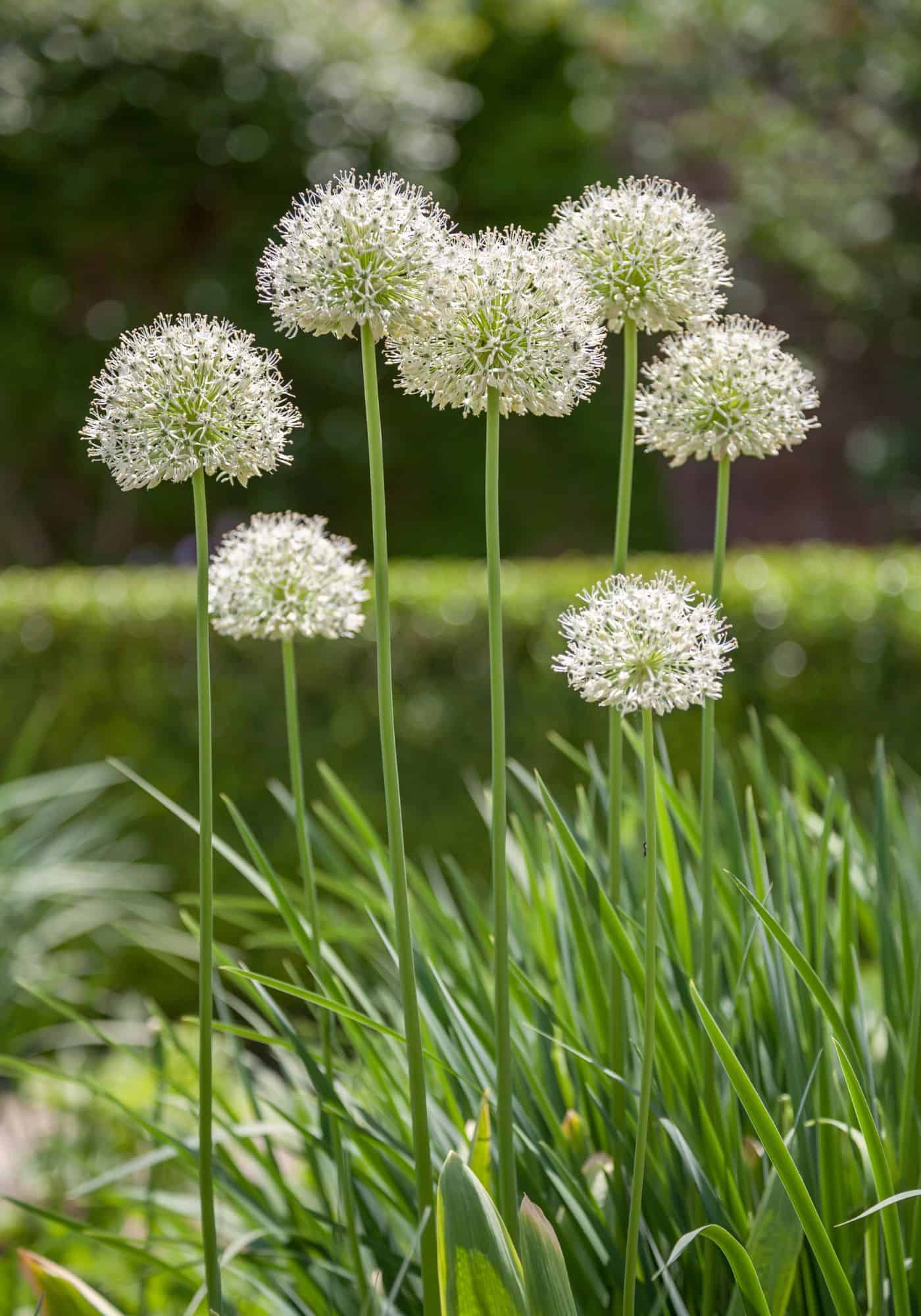
Caring for allium plants
After you plant alliums by placing your allium bulbs in the ground, it’s essential to remember that plant bulbs, like these, must receive proper care for healthy growth and survival.
Watering alliums
A consistent watering schedule is vital for the health and wellbeing of your alliums. Alliums require infrequent watering, generally only needing water when the soil is dry to the touch. During prolonged dry spells, be sure to pay extra attention to containers, as they can dry out quickly.
Remember, alliums prefer well-drained soil, so be careful not to overwater them. Overwatering can lead to bulb rot and other complications. By providing your alliums with the right amount of water, you’ll promote healthy growth and prevent drought stress.
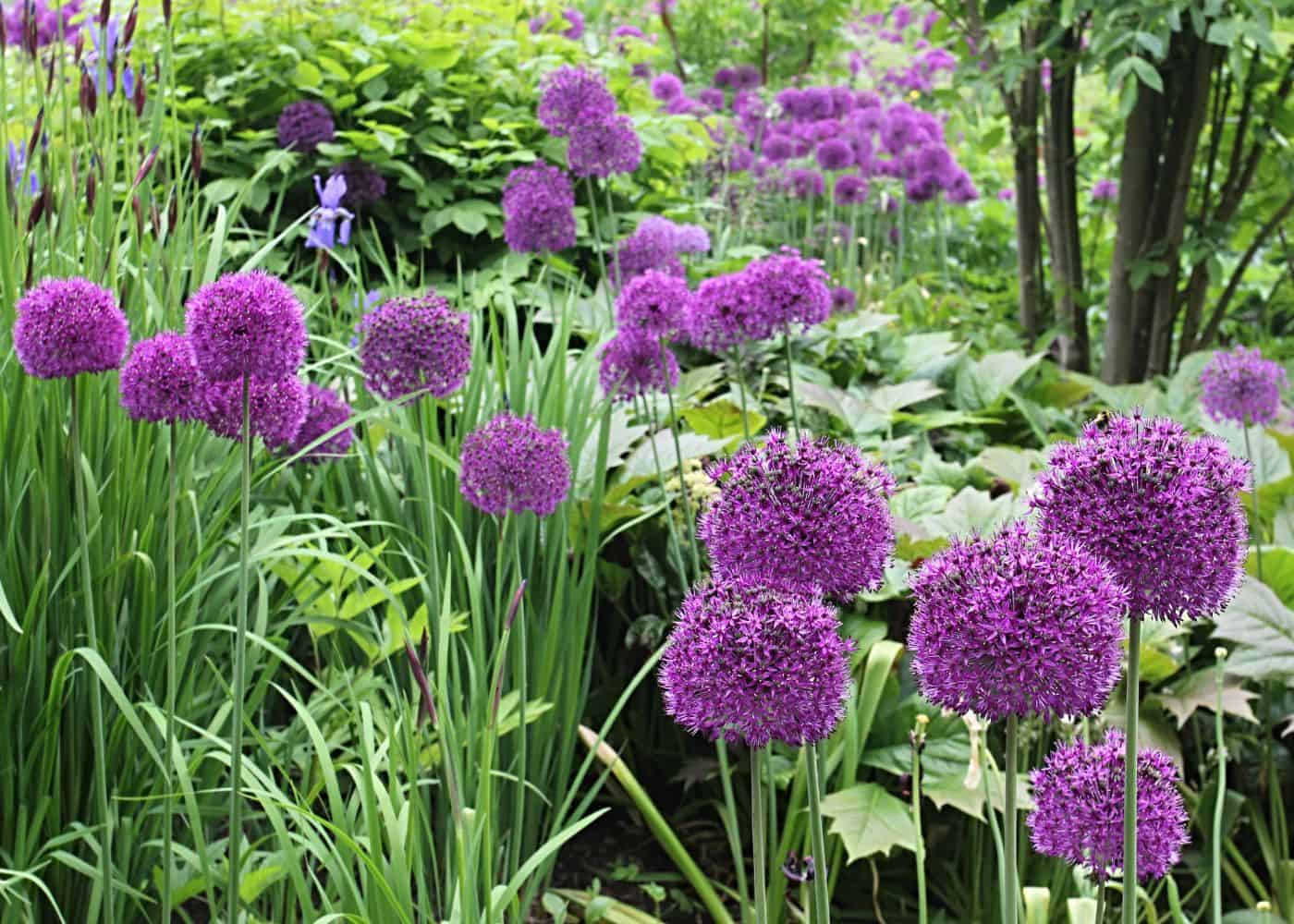
Fertilizing allium plants
For optimal growth and flowering, your alliums need fertilization. Alliums prefer soil that is enriched with nutrients, particularly nitrogen, phosphorus, and potassium. Apply a balanced fertilizer to your alliums when the bulbs or rhizomes are first planted in the ground and once more just after the shoots emerge from the ground.
Using a bulb fertilizer or a general-purpose fertilizer, according to the package instructions, will provide your alliums with the nutrients they need to grow and bloom. Be sure to water the fertilizer in well to help the nutrients reach the plant roots.
Deadheading the spent flowers
Maintaining the appearance of your alliums and encouraging energy storage and reseeding requires regular pruning and deadheading. To prune and deadhead your alliums, use sharp pruning shears to cut off the flower heads and foliage after the blooms have faded.
Leaving the spent allium blooms on the plant until they fall apart can provide aesthetic value as they dry and promote self-seeding. Allowing allium foliage to die back naturally after flowering will help the plant store energy for the next growing season, ensuring a beautiful display year after year. The spent flower heads can also provide winter interest if left standing through the colder months.
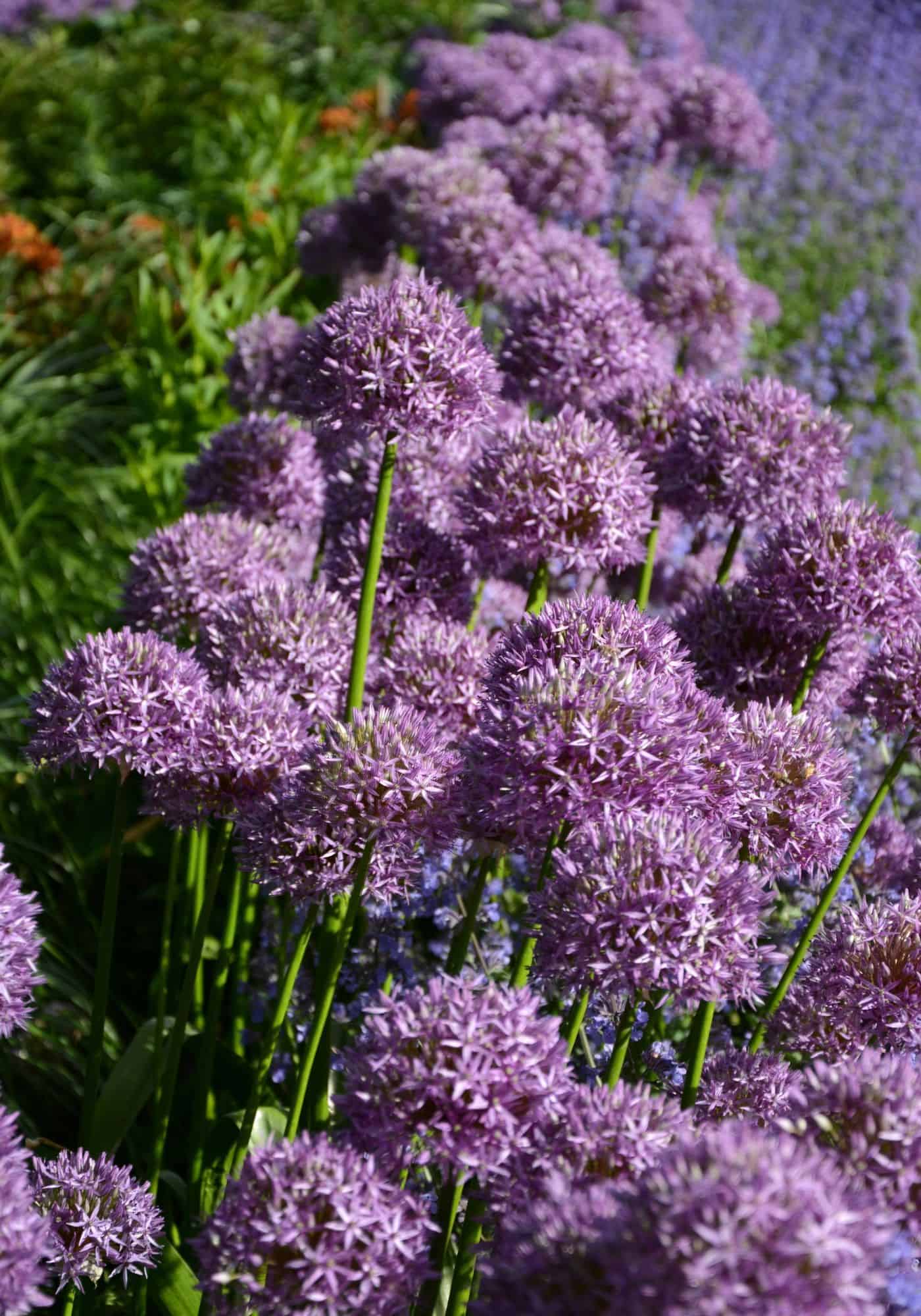
Supporting tall varieties
Tall allium varieties, such as ‘Gladiator’ and ‘Globemaster’, sometimes require support to prevent damage and maintain an attractive appearance. To provide support for tall alliums (especially in windy areas), you can use stakes or cages. Place the stakes around the plant and attach them to the stem to provide support. Cages can also be used to provide support and can be placed around the plant before it begins to grow.
Providing support to your tall alliums will help prevent damage from wind and heavy rain, as well as keep the stems upright and the flowers more visible. This will ultimately enhance the overall beauty of your allium garden.
Propagating alliums
If you’re looking to expand your allium garden or share the beauty of these plants with friends and family, propagating alliums is a rewarding and cost-effective way to do so.
This section illuminates two techniques for propagating alliums: bulb division and seed growth.
Dividing allium bulbs
One of the most effective methods for propagating alliums is by dividing the clumps of bulbs, preferably every 3-4 years. Here’s how to do it:
In the fall, gently dig up the plant.
Separate the bulbs along the visible division lines.
Replace the old bulb with a healthy one in the original spot.
Plant the spare bulbs in other parts of the garden.
Dividing allium bulbs not only helps propagate new plants but also promotes healthy growth and flowering in your existing alliums. By dividing your allium bulbs regularly, you can ensure a stunning display of these captivating plants in your garden year after year.
Growing alliums from seed
Growing alliums from seeds is another propagation option, although it may require more patience, as some species can take up to a year before producing blooms.
To start the germination process indoors, follow these steps:
Fill a tray with compost-amended potting soil.
Sow the seeds directly into the soil.
Place the tray in a warm and well-lit area.
Keep the soil moist but not waterlogged.
Wait for the seeds to germinate, which can take several weeks.
Alternatively, you can choose to sow the seeds directly into the garden in late spring. This time of year is more favorable in letting them take root, as heavy rains are less likely to wash them away.
For regions with moderate winter temperatures, sowing allium seeds is an option. This can be done in the late summer, fall or early winter. With proper care and a bit of patience, growing alliums from seeds will reward you with a beautiful and bountiful display of these striking plants.

Dealing with pests and diseases
While alliums are generally low-maintenance and resistant to many pests and diseases, it’s important to be proactive in protecting your plants from potential threats. This section provides guidance on maintaining the health and vigor of your alliums by addressing pests and diseases, including measures for animal deterrence, fungal disease prevention, and insect control.
Animal deterrents
One of the many advantages of growing edible alliums is their natural deterrent properties. Alliums are unpalatable to deer, rabbits, and rodents, making them an excellent choice for gardeners looking to protect their plants from these animals.
By incorporating alliums into your garden design, you can create a beautiful and harmonious space without worrying about animal damage.
Fungal diseases
Alliums can be affected by fungal diseases such as rot and downy mildew. To prevent and treat fungal diseases in your alliums, avoid overhead watering, as this can create a moist environment that encourages fungal growth. Remove and dispose of any infected bulbs to prevent the spread of the disease.
Taking these precautions can help keep your alliums healthy and free from fungal diseases, ensuring a beautiful and vibrant display throughout the growing season.
Insect pests
While alliums are generally resistant to many insect pests, they can still be affected by onion flies, allium leaf miners, and thrips. To identify and control these pests, monitor your plants regularly for signs of infestation and take appropriate action, such as using insecticides, removing affected plants, or encouraging beneficial insects like ladybugs and lacewings to help control the pests.
Encouraging beneficial insects is a great way to help control pests without the use of insect
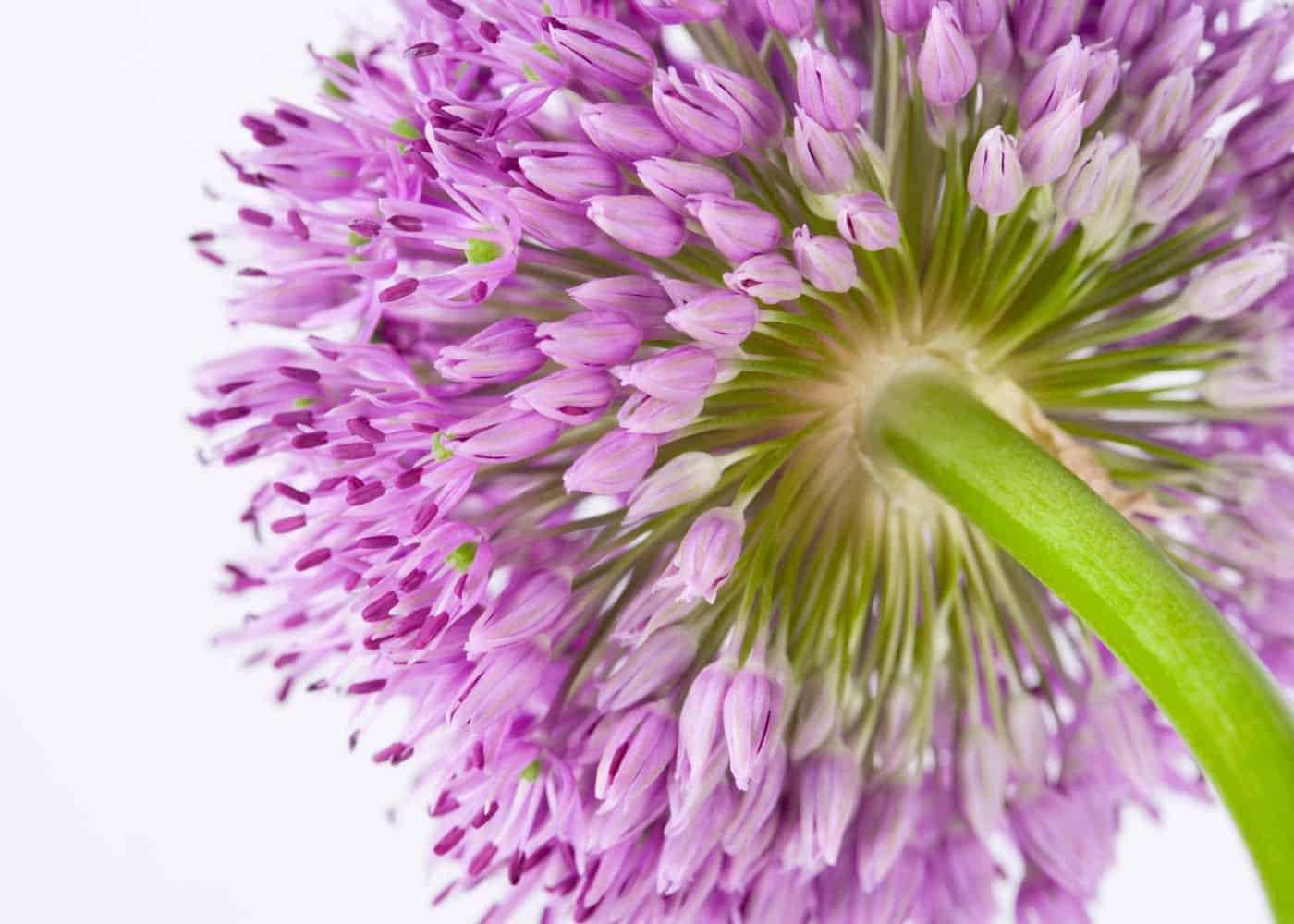
Companion planting with alliums
The beauty and health of your garden can be enhanced through companion planting with alliums. Pairing alliums with ornamental grasses, perennials, and annuals can create a harmonious and visually appealing garden design while providing added benefits, such as deterring animals and protecting other plants from vegetable-eating insects.
This section uncovers some of the best companion plants for alliums and ways to integrate them into your garden. You can also apply the guidelines of vegetable garden onion companions to these ornamental species.
Ornamental grasses
Ornamental grasses make excellent companion plants for alliums, as their fine textures and flowing forms create a stunning contrast to the bold, spherical flower heads of alliums. Some suitable ornamental grasses to pair with alliums include Calamagrostis x acutiflora ‘Karl Foerster’, Pennisetum varieties, and Stipa tenuissima.
Planting alliums, also known as ornamental onions, among ornamental grasses provides an attractive and low-maintenance garden design that will captivate visitors and add a touch of elegance to your outdoor space.
Perennials
Perennials are another excellent choice for companion planting with alliums. They offer a wide range of colors, textures, and forms that can complement the striking beauty of allium blooms. Some suitable perennials to pair with alliums include:
Daylilies
Echinacea
Salvia
Agastache
Nepeta
Geraniums
By incorporating perennials into your allium garden, you can create a harmonious and long-lasting garden design that will provide visual interest and color throughout the growing season.
Annuals
Annual plants that serve as wonderful companions for alliums include:
Verbascum
Alstroemeria
Erysimum
Artemisia
Carex
These plants provide a burst of color that complements the drumstick allium flowers as well as the drumstick alliums, adding variety to your garden design with ornamental alliums, purple flowers, and pink flowers during the spring bloom.
When selecting annuals to plant alongside your alliums, consider their growing requirements, bloom time, and color palette to ensure a cohesive and visually appealing display.
Showcasing alliums in the garden
Alliums, showcased in various ways throughout your garden, can create a stunning and eye-catching display. This section discusses optimal ways to incorporate alliums into your garden design, focusing on garden borders, rock gardens, and mixed plantings.
Garden borders
Using alliums in garden borders is an excellent way to create a dramatic and colorful display. Planting alliums alongside other perennials and ornamental grasses can create a harmonious and visually appealing border that showcases the beauty of these plants.
Choose a variety of alliums with different sizes, shapes, and colors to create a captivating and dynamic border. Taller varieties can be placed towards the back of the border, while shorter varieties can be used to create a carpet of color in the front. Experiment with different combinations and groupings to create a border that reflects your unique style and vision.
Rock gardens
Rock gardens provide another opportunity to showcase the beauty of alliums in your garden. Small allium varieties, such as Allium moly and Allium senescens subsp. montanum var. Glaucum, are particularly well-suited for rock gardens. Their petite size and vibrant blooms can add a pop of color and interest to the rocky landscape.
When incorporating alliums into your rock garden, consider their growing requirements and ensure they have well-draining soil and full sun exposure. Pair your alliums with other rock garden plants that have similar needs, creating a cohesive and visually appealing garden design.


